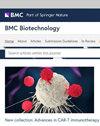从墨鱼(软体动物门:头足纲)中提取的类黄酮和酚类物质的抗菌和细胞毒性活性
IF 3.5
3区 生物学
Q2 BIOTECHNOLOGY & APPLIED MICROBIOLOGY
引用次数: 0
摘要
关于海洋软体动物不同萃取物的生物活性,此前已有多项研究报道。因此,我们决定评估红海中大量存在的 S. pharaonis 墨汁的细胞毒性和抗菌活性。我们从墨水中提取了黄酮类化合物,并分析了其成分。然后,我们系统地评估了这种提取物的细胞毒性和抗菌特性。我们还使用 SwissADME 进行了药代动力学研究,以评估从墨汁提取物中鉴定出的黄酮类化合物和酚类化合物作为口服活性药物候选物的潜力。在不同浓度(0.4 µg/mL、1.6 µg/mL、6.3 µg/mL、25 µg/mL、100 µg/mL)下,对 5 种细胞系(MCF7、Hep G2、A549 和 Caco2)的细胞毒活性进行了评估。萃取物以浓度依赖的方式降低了受检细胞的活力。萃取物对 A549 和 Hep G2 癌细胞系细胞的细胞毒性效果最高,IC50 分别为 2.873 和 7.1 µg/mL。流式细胞仪对该提取物的细胞周期进展和凋亡诱导机理分析表明,该提取物在 Hep G2 和 MCF7 中使细胞周期停滞在 S 期,而在 A549 中则使细胞停滞在 G1 期。然而,它在 Caco2 癌细胞系中会导致 G1 期和 S 期细胞周期的停滞。我们的数据显示,该提取物对所有测试的人类微生物病原体都有显著的抗菌活性。不过,对白色念珠菌(Candida albicans ATCC 10,221)的抑制效果最好,最低抑制浓度(MIC)为 1.95 µg/mL。使用 SwissADME 进行的药代动力学分析表明,大多数黄酮类和酚类化合物具有很高的药物相似性,因为它们符合利宾斯基标准,WLOGP 值低于 5.88,TPSA 值低于 131.6 Å2。S. pharaonis 墨汁乙醇提取物对多种细胞株具有良好的细胞毒性,对不同的病原微生物菌株具有显著的抗菌作用。法老墨汁是一种重要黄酮类化合物的新来源,未来可作为天然安全可行的合成药物替代品用于不同的应用领域。本文章由计算机程序翻译,如有差异,请以英文原文为准。
Antimicrobial and cytotoxic activities of flavonoid and phenolics extracted from Sepia pharaonis ink (Mollusca: Cephalopoda)
Several studies have been reported previously on the bioactivities of different extracts of marine molluscs. Therefore, we decided to evaluate the cytotoxic and antimicrobial activities of S. pharaonis ink as a highly populated species in the Red Sea. We extracted the flavonoids from the ink and analyzed their composition. Then we evaluated systematically the cytotoxic and antimicrobial properties of this extract. A pharmacokinetic study was also conducted using SwissADME to assess the potential of the identified flavonoids and phenolic compounds from the ink extract to be orally active drug candidates. Cytotoxic activity was evaluated against 5 cell lines (MCF7, Hep G2, A549, and Caco2) at different concentrations (0.4 µg/mL, 1.6 µg/mL, 6.3 µg/mL, 25 µg/mL, 100 µg/mL). The viability of examined cells was reduced by the extract in a concentration-dependent manner. The highest cytotoxic effect of the extract was recorded against A549 and Hep G2 cancer cell lines cells with IC50 = 2.873 and 7.1 µg/mL respectively. The mechanistic analysis by flow cytometry of this extract on cell cycle progression and apoptosis induction indicated that the extract arrests the cell cycle at the S phase in Hep G2 and MCF7, while in A549 cell arrest was recorded at G1 phase. However, it causes G1 and S phase arrest in Caco2 cancer cell line. Our data showed that the extract has significant antimicrobial activity against all tested human microbial pathogens. However, the best inhibitory effect was observed against Candida albicans ATCC 10,221 with a minimum inhibitory concentration (MIC) of 1.95 µg/mL. Pharmacokinetic analysis using SwissADME showed that most flavonoids and phenolics compounds have high drug similarity as they satisfy Lipinski’s criteria and have WLOGP values below 5.88 and TPSA below 131.6 Å2. S. pharaonis ink ethanolic extract showed a promising cytotoxic potency against various cell lines and a remarkable antimicrobial action against different pathogenic microbial strains. S. pharaonis ink is a novel source of important flavonoids that could be used in the future in different applications as a naturally safe and feasible alternative of synthetic drugs.
求助全文
通过发布文献求助,成功后即可免费获取论文全文。
去求助
来源期刊

BMC Biotechnology
工程技术-生物工程与应用微生物
CiteScore
6.60
自引率
0.00%
发文量
34
审稿时长
2 months
期刊介绍:
BMC Biotechnology is an open access, peer-reviewed journal that considers articles on the manipulation of biological macromolecules or organisms for use in experimental procedures, cellular and tissue engineering or in the pharmaceutical, agricultural biotechnology and allied industries.
 求助内容:
求助内容: 应助结果提醒方式:
应助结果提醒方式:


